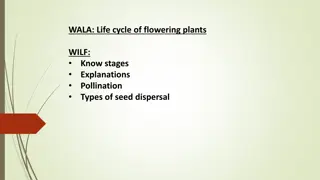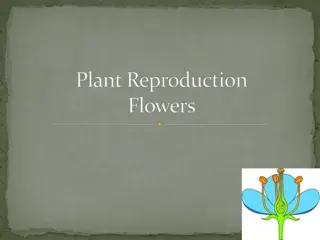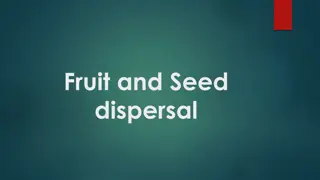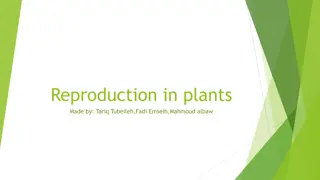Year 9 End of year revision
Learn how plants make their own food and the essential processes of photosynthesis. Discover why photosynthesis is crucial for maintaining oxygen and carbon dioxide levels. Explore leaf structure, chloroplast function, roles of carbon dioxide and water, and the significance of light energy. Uncover
0 views • 26 slides
Introduction to Gymnosperms: Key Characteristics and Features
Gymnosperms are seed-producing plants with exposed ovules, lacking fruits. They have true roots, stems, and leaves, with majority being tall, woody, perennial plants. Male and female flowers are borne on separate structures, and pollination occurs via wind. Gymnosperms exhibit unique features such a
6 views • 6 slides
Understanding the Importance of Bees as Pollinators in Ecosystems
Explore the vital role of bees in pollination through hands-on activities, educational videos, and discussions. Learn about the decline of honeybee populations and delve into innovative solutions like robotic pollinators. Engage in STEM challenges to redesign bee-like robots for effective pollinatio
3 views • 13 slides
Understanding Pollination: The Role of Pollinators in Plant Growth
In September, watch out for ivy bees feeding on nectar and gathering pollen from ivy flowers. Explore the significance of pollination, pollen, and pollinators in the plant life cycle. Discover how bees and other pollinators play a crucial role in food production and biodiversity. Engage in activitie
2 views • 9 slides
Understanding the Life Cycle of Flowering Plants
Explore the fascinating life cycle of flowering plants, from pollination to seed dispersal. Discover the stages, types of pollination, and various methods of seed dispersal through engaging visuals and resources. Enhance your knowledge and understanding of plant biology with interactive activities a
1 views • 7 slides
Pollen Grain Development
The process of pollen grain development and formation of the male gamete involves crucial stages such as the presence of diploid microspore mother cells in the stamen, meiosis resulting in the formation of four haploid cells and tetrads, mitosis leading to the development of two haploid nuclei in ea
0 views • 6 slides
Understanding Different Emasculation Techniques in Plant Breeding
Learn about the significance of emasculation in plant breeding to prevent self-pollination and facilitate controlled pollination. Explore various methods such as hand emasculation, forced open method, clipping method, emasculation with hot/cold water, alcohol, suction method, chemical emasculation,
2 views • 10 slides
Understanding Seed Dispersal in Flowering Plants
Explore the fascinating world of seed dispersal in flowering plants, from wind dispersal to bursting pods and shaking mechanisms. Discover the various methods plants use to spread their seeds and ensure their survival. Dive into the stages of a flowering plant's life cycle and learn how germination,
1 views • 16 slides
Understanding Pollination: Types and Factors
Pollination is the crucial process of transferring pollen for fertilization and seed production in plants. It can be self-pollination or cross-pollination, with different types of dehiscence affecting how pollen is released. Self-pollination occurs in hermaphroditic and monoecious plants, with facto
0 views • 22 slides
Understanding Different Methods of Emasculation Techniques in Plant Breeding
Emasculation is a crucial technique in plant breeding to prevent self-pollination and prepare for controlled pollination. Various methods like hand emasculation, hot/cold water, alcohol, and more are used depending on the crop and flower size. Emasculation is key for hybridization in monoecious and
0 views • 12 slides
Sustainable Beekeeping Initiatives for a Green Caribbean at the 9th Caribbean Beekeeping Congress
Addressing challenges such as poverty, food security, deforestation, and climate change, the focus is on promoting beekeeping in Guyana as a key component of the Green State Development Strategy. Beekeeping plays a critical role in pollination, ensuring the survival of plants and agriculture. Previo
0 views • 25 slides
Understanding Plant Reproduction through Flowers
Explore the intricate process of plant reproduction through flowers, including the functions of various flower parts, the types of flowers (perfect vs. imperfect), the significance of pollination, and the different pollination vectors involved in ensuring successful reproduction in plants.
0 views • 12 slides
Understanding Pollination Biology and the Importance of Honeybees
Pollination is a crucial process for plant reproduction, with both abiotic and biotic methods. Self- and cross-pollination play essential roles, relying on various agents like insects. Honeybees, vital pollinators, have a significant impact on food production and ecosystem balance, demonstrating the
0 views • 18 slides
Understanding Sexual Reproduction in Flowering Plants
Explore the fascinating process of sexual reproduction in flowering plants, presented by Mr. Rajeshkukar, Principal of Kendriya Vidyalaya No. 1 Devlali. Discover the parts of a flower, including the androecium and gynoecium, stamen, anther structure, and microsporogenesis. Dive into the intricate de
8 views • 35 slides
Understanding Apiculture: The Art and Science of Beekeeping
Apiculture, also known as beekeeping, involves the care and management of honey bees to produce honey and wax. This ancient practice is not only significant for its commercial products but also plays a crucial role in pollination and potentially medical research. Discover more about the importance,
0 views • 14 slides
Understanding Pollination, Fertilization, and Flower Features
Explore the intricate processes of pollination and fertilization in plants, including self-pollination and cross-pollination. Discover how wind-pollinated and insect-pollinated flowers differ in features and mechanisms. Dive into the fascinating world of plant reproduction through informative visual
0 views • 8 slides
Fascinating Facts About Bats Around the World
Bats are incredible mammals found in various habitats worldwide, with over 1,300 species known. They play vital roles such as pollination, pest control, and seed dispersal. From the tiny bumblebee bat to the giant flying foxes, bats showcase diverse adaptations and behaviors like echolocation and un
0 views • 19 slides
The Devastating Impact of Colony Collapse Disorder on Honey Bees
A profound look into the catastrophic effects of Colony Collapse Disorder (CCD) on honey bee populations, causing the loss of millions of beehives and threatening crop pollination. Scientists attribute CCD to a deadly mix of fungicides and pesticides found in pollen samples, disrupting bees' neurolo
0 views • 6 slides
Understanding Pollination: How Bees Help Plants Grow
Discover the fascinating relationship between bees and flowers, where bees play a vital role in pollination, aiding in the growth of plants and the production of fruits and seeds. Explore how bees need flowers for pollen and nectar, and how plants rely on bees to spread their pollen for reproduction
0 views • 10 slides
Understanding the Vital Relationship Between Bees and Flowers
Explore the significance of bees in pollination, the role of pollen in flower reproduction, and how bees contribute to plant growth. Dive into the world of nectar collection, honey production, and the mutualistic relationship between insects and flowers. Discover the essential interdependence betwee
0 views • 15 slides
Enhancing Cataloging Workflow with Project Passage and Wikibase
Explore the OCLC Project Passage, a cataloging platform using Wikibase, evaluated by 16 member libraries. Learn about the cataloging interface, challenges in workflow interruption, and the retriever tool for aligning data from Wikidata, VIAF, and FAST. Enhance your cataloging process with cross-poll
4 views • 28 slides
Harvesting and Postharvest Techniques for Quality Seed Production
Understand the importance of harvesting crops at the right timing to maximize seed quality. Learn about half-matured and full-matured stages, postharvest ripening, and indicators for precise timing. Discover the significance of counting days from flowering/pollination for determining harvest timing.
0 views • 24 slides
The Buzz About Bees: Facts, Importance, and How You Can Help!
Bees play a crucial role in our ecosystem and food supply, with over 20,000 species aiding in pollination. Sadly, bee populations are declining due to various factors like climate change, pesticides, and habitat loss. Understanding the significance of bees, their pollination process, and the risks t
0 views • 11 slides
Discovering Pollinating Insects in the UK
Learn about the diverse world of pollinating insects in the UK, including bees, moths, wasps, butterflies, beetles, and flies. Explore how these insects play a crucial role in pollination, benefiting plant ecosystems. Engage in a fun learning activity to spot different pollinators in the wild and un
0 views • 7 slides
Plant Reproduction: Pollination and Seed Dispersal Mechanisms
Explore the fascinating world of plant reproduction through pollination and seed dispersal mechanisms. Learn about the different types of pollination, such as self-pollination and cross-pollination, and the importance of fruit and seed dispersal. Discover how plants use various strategies to ensure
0 views • 6 slides
Understanding Altruism, Kin Selection, and Social Insects in Sustainability
Altruism, kin selection, and social insects play crucial roles in sustainability. Altruistic behavior, like reciprocal altruism and kin selection, benefits recipients while potentially harming donors. Social insects, such as bees and ants, exemplify cooperation and societal structures that aid in ec
0 views • 29 slides
Understanding Reproduction in Plants: Types, Processes, and Examples
Reproduction in plants involves both sexual and asexual methods, each with distinct processes and outcomes. This article delves into the types of reproduction, including sexual and asexual processes, explaining their mechanisms, examples in plants, and the importance of pollination. It contrasts ase
0 views • 25 slides
Flowering Plant Reproduction: Pollination, Fertilisation, and more
Explore the process of pollination and fertilisation in flowering plants through an interactive quiz. Learn about the fusion of gametes, formation of endosperm and zygote, seed development, and more. Test your knowledge on plant reproduction and understand the intricate mechanisms involved.
1 views • 50 slides
All About Hazelnut: Growth, Features, Animals, Pests, Seeds, Reproduction
Hazelnuts, also known as Corylus Americana, thrive in rich, moist soils and can be found near stream sides. They grow up to 8-12 feet, with leaves turning red, orange, and green in fall. Various animals feed on hazelnuts, while pests like the eastern filbert blight pose a threat. The nuts have one o
0 views • 8 slides
Explore the Fascinating Life Cycle of Plants
Delve into the mesmerizing process of how plants grow, from seeds to adults, highlighting the essential elements of sun, soil, and water for their growth. Witness the role of bees, birds, and animals in pollination, leading to the formation of fruits and vegetables. Embark on a journey through the c
0 views • 15 slides
Understanding Market Failure, Externalities, and Public Goods
Market failure occurs when the equilibrium is not Pareto efficient, often due to externalities where the actions of individuals or firms impact others without compensation. Positive externalities like bee pollination and negative externalities such as air pollution from power plants are examples. By
0 views • 39 slides
Understanding the Basics of Genetics with Gregor Mendel
Fundamentals of genetics involve the study of how traits are passed from parents to offspring, as demonstrated by Gregor Mendel's experiments with garden peas. Through his work, Mendel identified key concepts such as purebred and hybrid traits, generations, and the role of dominant and recessive fac
0 views • 14 slides
Guide to Growing and Using Highbush Cranberries
Highbush Cranberry, also known as Viburnum trilobum, is a versatile shrub with dark green leaves that turn maroon in fall. It thrives in moist, slightly acidic soils, producing bright red or orange fruit that persists through winter. This plant is native to Canada and requires cross-pollination for
0 views • 7 slides
Understanding the Parts and Functions of a Flower
Explore the intricate components of a flower, including male and female reproductive parts, through informative images and descriptions. Learn about perfect and imperfect flowers, male (stamen) and female (pistil) parts, as well as other vital flower structures like petals, sepals, and roots. Delve
0 views • 10 slides
Flower Pollination Algorithm: Nature-Inspired Optimization
Real-world design problems often require multi-objective optimization, and the Flower Pollination Algorithm (FPA) developed by Xin-She Yang in 2012 mimics the pollination process of flowering plants to efficiently solve such optimization tasks. FPA has shown promising results in extending to multi-o
0 views • 15 slides
Understanding Flower Dissection and Reproduction Process
Angiosperms are seed-bearing plants that produce flowers containing essential and accessory organs for reproductive functions. The stamen and pistil play key roles in the male and female reproductive processes, leading to fertilization and seed formation. Pollination, germination, and fruit developm
0 views • 14 slides
Understanding Life Cycles: Plants and Animals
Explore the fascinating world of life cycles in plants and animals through engaging visuals and descriptions. From the process of germination to the different stages of growth and development, discover how living organisms move through their life cycles. Topics include plant pollination, seed disper
0 views • 14 slides
The Vital Role of Bees in Pollination for Food Production
Bees play a crucial role in pollination, helping to produce a variety of foods like fruits, vegetables, and herbs that end up on our plates. This process involves bees transferring pollen between plants, leading to the development of crops such as strawberries and peas. Without bees and other pollin
0 views • 9 slides
Understanding Plant Reproduction: Types, Processes, and Examples
Explore the fascinating world of plant reproduction through this comprehensive guide. Learn about sexual and asexual reproduction, their differences, and examples in plants. Discover the importance of pollination, the roles of plant parts, and the various methods of asexual reproduction in plants. E
0 views • 26 slides
Understanding Heterosis Breeding in Cabbage: A Comprehensive Overview
Cabbage, a popular vegetable, has evolved from its non-heading types to heading varieties. Its growth has expanded to various regions in India due to heat-tolerant varieties and F1 hybrids. Cabbage is highly cross-pollinated, with up to 73% cross-pollination due to self-incompatibility. Bees and fli
0 views • 47 slides







































